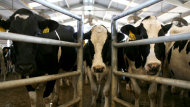Mad Cow Disease Found in U.S. Cow
By CARRIE GANN and DAN CHILDS | Good Morning America – 11 hours ago
The Department of Agriculture today confirmed a case of mad cow disease found in a dairy cow in central California.
In a press briefing today, John Clifford, the USDA's chief veterinary officer, said the cow's meat did not enter the food supply and the carcass will be destroyed.
The animal was found at a rendering facility run by Baker Commodities in Hanford, Calif. The disease was discovered when the company selected the cow for random sampling, Baker Commodities executive vice president Dennis Luckey told The Associated Press.
The Agriculture Department confirmed today that the cow is the fourth discovered in the United States to test positive for the disease, but stressed that consumers were not at risk because the animal was not bound for the food supply.
"There is really no concern for alarm here with regards to this animal," Clifford said. "Both human health and animal health are protected with regards to this issue."
Government officials were quick to reassure the public that the finding posed no threat to humans.
"The beef and dairy in the American food supply is safe and USDA remains confident in the health of U.S. cattle," Agriculture Secretary Tom Vilsack said in a statement. "The systems and safeguards in place to protect animal and human health worked as planned to identify this case quickly, and will ensure that it presents no risk to the food supply or to human health. USDA has no reason to believe that any other U.S. animals are currently affected, but we will remain vigilant and committed to the safeguards in place."
The Food and Drug Administration pledged to "work with the USDA to fully investigate the feed supply as part of the epidemiological investigation." And the USDA said in a statement that milk does not transmit mad cow disease.
This is the fourth case of mad cow disease in the U.S. cattle supply since December 2003. The first U.S. BSE case was in 2003, found in a Washington state dairy cow that had been slaughtered. The second case was found in June 2005 in a cow in Texas, and the third was found in a cow in Alabama in 2006.
The case today was discovered as part of the USDA's regular surveillance program of U.S. cattle. No other cases have been reported yet, and Dr. William Schaffner, chair of preventive medicine at Vanderbilt University, said it's unlikely that more cows will be infected. "Mad cow occurs in animals as it does in humans -- rarely and sporadically. At this point, I would not expect there to be another cow to be found," he said.
Mad cow disease, otherwise known as variant Cruetzfeld Jakob (vCJD) disease, affects the brain and spine of an animal. Those body parts are kept out of grocery stores and restaurants and have no contact with the meat that does make its way to consumers.
While many diseases are caused by bacteria and viruses, mad cow disease is caused by a transmissible protein called a prion, according to the U.S Centers for Disease Control and Prevention. While the function of these proteins in nature is unknown, what is known is that they act on the human nervous system to cause rapid brain degeneration.
Those who have the disease tend to experience a progressive neurological or psychiatric disorder that lasts longer than six months with symptoms including dementia, seizure, unusual sensory symptoms, dizziness, or progressive unusual mood changes. The illness usually lasts 14 months, and the disease is always fatal. As of last year, 221 cases of probable vCJD had been reported. This includes 172 in the United Kingdom, 25 in France, five in Spain, four in Ireland and three in the United States, with a smattering of cases in other countries around the world. The patients that were diagnosed in the United States were thought to have been infected while they were residing in the UK or living abroad in Saudi Arabia.
No humans have ever been reported to have been infected with mad cow disease in the United States, but fears of the disease became prominent in the 1990s when nearly 150 people in Britain died from the brain-wasting disease.




No comments:
Post a Comment